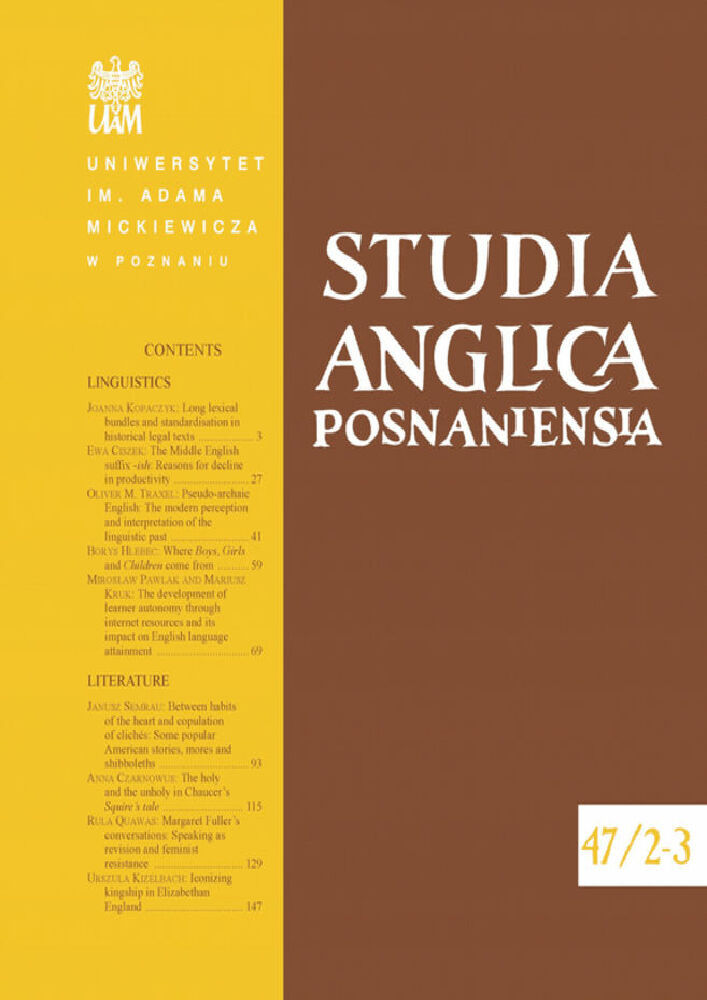Abstract
In this paper we look at two seemingly unrelated historical processes: affrication of the Old English (OE) palatalized velars [kj] > [tʃ], e.g., OE cild > PDE child, OE cīosan > PDE choose, and the Middle English (ME) vowel unrounding [y] > [i] and [ø] > [e]. More specifically, it is argued that the front rounded vowels [y] and [ø], as well as the palatalized velars [kj] and [j], are complex melodic expressions containing two antagonistic resonance elements |I| and |U|. Furthermore, it is proposed here that the phonological system of ME witnessed a drastic change as a consequence of the introduction of the ban on the |I| and |U| merger. This *|I U| constraint is responsible for the loss of the resonance element |U| from the internal structure of both segments, which leads to the unrounding of the i-umlauted vowels and the affrication of the palatalized velars. This paper provides a detailed analysis of velar palatalization and its subsequent affrication, while additionally we address the questions of the lack of affrication before both i-umlauted and unrounded vowels, the palatalization and vocalization of the voiced velar fricative /ɣ/ and the chronology of affrication in the history of English.
References
Backley, Phillip. 2011. An introduction to Element Theory. Edinburgh University Press. DOI: https://doi.org/10.1515/9780748637447
Backley, Phillip & Kuniya Nasukawa 2009. Representing labials and velars: A single ‘dark’ element. Phonological Studies 12. 3–10.
Bateman, Nicoleta. 2007. A crosslinguistic investigation of palatalization. Unpublished PhD. dissertation, UC San Diego. https://escholarship.org/uc/item/13s331md
Bateman, Nicoleta. 2011. On the typology of palatalization. Language and Linguistics Compass 5(8). 588–602. DOI: https://doi.org/10.1111/j.1749-818X.2011.00294.x
Bloch-Rozmej, Anna. 2008. Melody in Government Phonology. Wydawnictwo KUL.
Broadbent, Judith M. 1996. The representation of coronal segments. Unpublished Ph.D. dissertation, University College London.
Campbell, Alistair. 1959. Old English grammar. Clarendon Press.
Clements, G. N. & Elizabeth V. Hume 1995. The internal organization of speech sounds. In John A. Goldsmith (ed.), The handbook of phonological theory, Blackwell. 245–306.
Cyran, Eugeniusz. 2010. Complexity scales and licensing in phonology. De Gruyter Mouton. DOI: https://doi.org/10.1515/9783110221503
Gussmann, Edmund. 2007. The phonology of Polish. Oxford University Press.
Harris, John. 1994. English sound structure. Blackwell.
Harris, John & Geoff Lindsey. 1995. The elements of phonological representation. In Jacques Durand & Francis Katamba (eds.), Frontiers of phonology: Atoms, structures, derivations, Longman. 34–79.
Harris, John & Geoff Lindsey. 2000. Vowel patterns in mind and sound. In Noel Burton-Roberts, Philip Carr & Gerard Docherty (eds.), Phonological knowledge: Conceptual and empirical issues, Oxford University Press. 185–205.
Hogg, Richard M. 1979. Old English palatalization. Transactions of the Philological Society 77(1). 89–113. DOI: https://doi.org/10.1111/j.1467-968X.1979.tb00358.x
Hogg, Richard M. 1992a. A grammar of Old English. Vol.1: Phonology. Blackwell.
Hogg, Richard M. 1992b. Phonology and morphology. In Richard M. Hogg (ed.), The Cambridge history of the English language. Vol. 1: The beginnings to 1066, Cambridge University Press. 67–167. DOI: https://doi.org/10.1017/CHOL9780521264747.004
Huber, Daniel. 2007. Velars and processes: Their treatment in phonological theory. Unpublished Ph.D. dissertation, Eötvös Loránd University Budapest.
Hyman, Larry M. 1975. Phonology: Theory and analysis. Holt, Rinehart & Winston, Inc.
Jordan, Richard. 1974. Handbook of Middle English grammar: Phonology. (transl. by Eugene J. Crook.) De Gruyter Mouton. DOI: https://doi.org/10.1515/9783110879414
Kaye, Jonathan, Jean Lowenstamm & Jean-Roger Vergnaud. 1985. The internal structure of phonological elements: A theory of charm and government. Phonology Yearbook 2(1). 305–328. DOI: https://doi.org/10.1017/S0952675700000476
Kaye, Jonathan, Jean Lowenstamm & Jean-Roger Vergnaud. 1990. Constituent structure and government in phonology. Phonology 7(1). 193–231. DOI: https://doi.org/10.1017/S0952675700001184
Kehrein, Wolfgang. 2002. Phonological representation and phonetic phasing: Affricates and laryngeals. Niemeyer. DOI: https://doi.org/10.1515/9783110911633
Kijak, Artur. 2017. Labial-dorsal interactions: A phonologically based approach. Wydawnictwo Uniwersytetu Śląskiego.
Kijak, Artur. 2021. Two palatovelar fricatives?! The case of the Ich-Laut in German. Poznań Studies in Contemporary Linguistics 57(2). 249–271. DOI: https://doi.org/10.1515/psicl-2021-0011
Lass, Roger. 1994. Old English. A historical linguistic companion. Cambridge University Press. DOI: https://doi.org/10.1017/CBO9780511621000
Lass, Roger & John M. Anderson 1975. Old English phonology. Cambridge University Press.
Lavoie, Lisa. 2009. Testing consonant weakness phonetically. In Donka Minkova (ed.), Phonological weakness in English: From Old to Present-Day English, Palgrave Macmillan. 29–46. DOI: https://doi.org/10.1007/978-0-230-29686-2_3
Lin, Yen-Hwei. 2011. Affricates. In Marc van Oostendorp, Colin J. Ewen, Elizabeth V. Hume & Keren Rice (eds.), The Blackwell companion to phonology. Vol.1, Wiley-Blackwell. 367–390. DOI: https://doi.org/10.1002/9781444335262.wbctp0016
Luick, Karl. 1964. Historische Grammatik der englischen Sprache. Blackwell.
Minkova, Donka. 2003. Alliteration and sound change in early English. Cambridge University Press. DOI: https://doi.org/10.1017/CBO9780511486968
Minkova, Donka. 2014. A historical phonology of English. Edinburgh University Press. DOI: https://doi.org/10.1515/9780748634699
Minkova, Donka. 2016. From stop-fricative clusters to contour segments in Old English. In Don Chapman, Colette Moore & Miranda Wilcox (eds.), Studies in the history of the English language VII: Generalizing vs. particularizing methodologies in historical linguistic analysis, De Gruyter Mouton. 29–59. DOI: https://doi.org/10.1515/9783110494235-003
Minkova, Donka. 2019. Examining the evidence for phonemic affricates: ME /tʃ/, /dʒ/ or [t-ʃ], [d- ʒ]? In Rhona Alcorn, Joanna Kopaczyk, Bettelou Los & Benjamin Molineaux (eds.), Historical dialectology in the digital age, Edinburgh University Press. 156–184. DOI: https://doi.org/10.3366/edinburgh/9781474430531.003.0008
Pater, Joe. 2009. Weighted constraints in generative linguistics. Cognitive Science 33(6). 999– 1035. DOI: https://doi.org/10.1111/j.1551-6709.2009.01047.x
Pater, Joe. 2016. Universal grammar with weighted constraints. In John McCarthy & Joe Pater (eds.), Harmonic Grammar and harmonic serialism, Equinox Press. 1–46.
Penzl, Herbert. 1947. The phonemic split of Germanic k in Old English. In Roger Lass (ed.), 1969. Approaches to English historical linguistics. An anthology, Holt, Rinehart and Winston Inc. 97–108. (originally published in 1947, Language 23(1), 34–42.) DOI: https://doi.org/10.2307/409706
Polgárdi, Krisztina. 1998. Vowel harmony. An account in terms of government and optimality. LOT.
Scheer, Tobias. 1999. A theory of consonantal interaction. Folia Linguistica 32(3–4). 201–237. DOI: https://doi.org/10.1515/flin.1998.32.3-4.201
Scheer, Tobias. 2004. A lateral theory of phonology. Vol. 1: What is CVCV, and why should it be? De Gruyter Mouton. DOI: https://doi.org/10.1515/9783110908336
Stenbrenden, Gjertrud F. 2019. Old English and its sound correspondences in Old English and Middle English. English Language and Linguistics 24(4). 687–718. DOI: https://doi.org/10.1017/S1360674319000182
Wright, Joseph & Elizabeth M. Wright. 1925. Old English grammar. (3rd edn.) Oxford University Press.
License
Copyright (c) 2023 Artur Kijak

This work is licensed under a Creative Commons Attribution-NonCommercial-NoDerivatives 4.0 International License.
